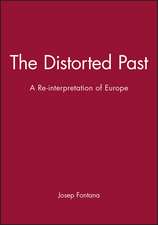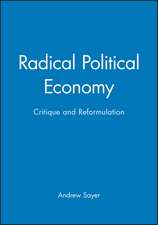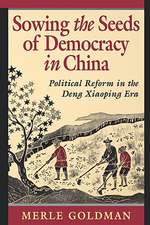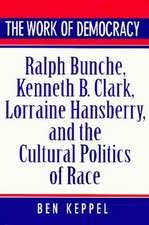Shaping Holland: Regional Design and Planning in the Southern Randstad
Autor Jeroen van Schaick, Francisco Colombo, Peter Witsenen Limba Engleză Paperback – 30 mar 2022
Shaping Holland gives a unique insight into the emergence of contemporary regional planning and design practice in the Netherlands. This densely populated country in the delta of the Rhine and Meuse rivers is internationally renowned for its urban planning and design tradition. Drawing on first-hand accounts and a rich collection of illustrations, maps and diagrams, the book gives pointers for practitioners, academics and students of spatial planning, urban design and landscape architecture.
Regional design is on the rise in all continents. It provides an answer to a world in which economic activities, activity patterns, urban growth and ecological systems are no respecters of administrative boundaries. Amid the growing number of academic analyses of regional design, this book is unique because it focuses on planning practice and first-hand knowledge. As such it is of interest to a broad international readership.
Preț: 264.45 lei
Nou
Puncte Express: 397
Preț estimativ în valută:
50.61€ • 52.28$ • 42.12£
50.61€ • 52.28$ • 42.12£
Carte disponibilă
Livrare economică 04-18 martie
Livrare express 18-22 februarie pentru 53.76 lei
Preluare comenzi: 021 569.72.76
Specificații
ISBN-13: 9781032022611
ISBN-10: 1032022612
Pagini: 284
Ilustrații: 203 Halftones, color; 203 Illustrations, color
Dimensiuni: 210 x 280 x 20 mm
Greutate: 1 kg
Ediția:1
Editura: Taylor & Francis
Colecția Routledge
Locul publicării:Oxford, United Kingdom
ISBN-10: 1032022612
Pagini: 284
Ilustrații: 203 Halftones, color; 203 Illustrations, color
Dimensiuni: 210 x 280 x 20 mm
Greutate: 1 kg
Ediția:1
Editura: Taylor & Francis
Colecția Routledge
Locul publicării:Oxford, United Kingdom
Public țintă
Postgraduate, Professional, Professional Practice & Development, and Undergraduate AdvancedCuprins
Introduction 1. Coast 2. Urban growth 3. Landscape The Civil Servant / The Politician / The Director 4. Corridors 5. Regional transit-oriented development 6. Beyond the port The Researcher / The Advisor / The Academic 7. Regional Design Principles for the Future
Recenzii
"In the 21st century, climate change will be the biggest differentiator between the haves and have-nots. As some of our lands become uninhabitable, the key to determining who will thrive and who will merely survive will be how prepared our communities areto make the tough choices. Only by working regionally will we be able to answer the tough questions: who will be forced to relocate, where they will go, and what will happen to communities receiving new neighbors to an often already-taxed infrastructure. "Shaping Holland" dives straight into those complexities to create a thoughtful approach to address how future generations can adapt to a wetter, dryer, hotter and colder environment."
- Amy Chester, Managing Director, Rebuild by Design
"This richly illustrated book brings together a highly competent and experienced group of contributors including scholars, researchers, consultants and practitioners to provide a diverse set of insights into the Dutch renowned experimentations with regional spatial planning and design, using South Randstad as a high profile example. The book draws on wide range of approaches to the concept of ‘regional design’ and goes beyond the conventional understanding of ‘the region’ as a bounded spatial scale, and ‘design’ as an outcome. The book is an excellent example of how a productive link can be forged between visual and textual narratives, and how synergies can be generated from multiple ways of knowing and articulating socio-spatial relations."
- Professor Simin Davoudi, Director of Global Urban Research Unit, School of Architecture, Planning and Landscape, Co-Director of Centre for Researching Cities, Newcastle University, UK
"This book reports on regional designs that were undertaken in Holland over the past 20 years from different perspectives: from the point of view of the practice of regional design, using illustrations of numerous practical design projects, through the lenses of the intellectual endeavors of the sciences that engaged in concept and theory formation, and last but not least, from the perspective of personal experience of responsible politicians, top policy makers, a planning director as well as an academic researcher, a planning advisor, and a professor in the planning sciences.
The result is a diverse, animated and informative compendium that can be read with different intentions and intensities. After a general introduction to the performance and position in-between central government and municipalities of Dutch regional design, it provides six thematic chapters – titled Coast, Urban Growth, Landscape, Corridors, Regional Transit-Oriented Development, and Beyond the Port – and also briefly presents the most important "lessons" that one should take away from reading the individual chapters.
This book could only be written in The Netherlands, building on an early planning culture that is still powerful today and which can ultimately be traced back to the centuries-old compulsion to control water.
Regional design, as it is presented here, differs fundamentally from the making of plans which determine future development in a binding way. Regional design aims to identify the spatial implications of future socio-economic and technical problems, and to fathom and visualize spatial strategies for overcoming them. Regional design forms a basis for discussion in professional and political arenas. Regional design tells vivid stories, e.g. about the layering of the earth, about landscape-architectural characteristics, about the often conflicting interests that affect landscapes, about new economic and old natural cycles - always with the aim of composing a vivid and attractive image from the "stories," one that stimulates and inspires the imagination.
Particularly beautiful examples are the "Sand engine," which uses characteristics of natural flows to stabilize and expand the beaches, the synopsis of the port industry and the glass house industry and the new development spaces that are opened up by this merging. And last but not least, the conception of a new type of "Parkstad" (Park City) that emerges from the permeation of urban development and agricultural production. I feel this tension between rational analysis and the creative invention of new spaces of possibility as a particularly valuable contribution of the Dutch variety of regional design.
What could this book mean for the spatial planning debate in Germany? It could provide vital inspiration for releasing regional planning from its bureaucratic constrictions and for the development of a more creative regional planning approach. Everyday life has long ago exceeded the boundaries of the municipality and takes place in the region. Climate change, resource preservation and the circular economy call for a synopsis on a regional scale!"
- Thomas Sieverts, award-winning architect, planner and urban theorist. He was a Professor of Urban Design at Technical University Darmstadt, and in 2000 become a Partner of S.K.A.T. Architecten und Stadtplaner. He is the author of Zwischenstadt (1997; first published in English in 2000 as Cities without Cities: An interpretation of the Zwischenstadt)
"This insightful book enhances and introduces regional design as a powerful technique to bridge the gap between regional planning and urban design. It is an inspiring contribution that adds value to current research-based and governance-oriented regional problem-solving, offering a methodology to face the regional era of global urbanization. Reshaping spatial planning with a broader sense of design, regional design is a revolutionary theory of shaping regions, based on the Southern Randstad experience, showing how regional development could be given direction and be transformed."
- Shifu Wang, Professor of Urban Planning, School of Architecture, South China University of Technology
"The regional governance debate is gridlocked between two contrary positions. While some argue that formal administrative boundaries need to be better aligned with functional urban areas to resolve challenges on supra-local scales, others insist on working within the given boundaries to preserve local identity and facilitate inter-municipal competition.
The proposition of a design exercise at regional scale shifts the discourse from issues of formal governmental re-organisation towards multi-scalar and inter-scalar methodologies for imagining and narrating alternative spatial futures. ‘Shaping Holland’ conveys convincingly that regional designing is possible and impactful. Regional design thus is necessary for any structural transformation as a means to overcome pressing contemporary challenges."
- Alain Thierstein, TU Munich
- Amy Chester, Managing Director, Rebuild by Design
"This richly illustrated book brings together a highly competent and experienced group of contributors including scholars, researchers, consultants and practitioners to provide a diverse set of insights into the Dutch renowned experimentations with regional spatial planning and design, using South Randstad as a high profile example. The book draws on wide range of approaches to the concept of ‘regional design’ and goes beyond the conventional understanding of ‘the region’ as a bounded spatial scale, and ‘design’ as an outcome. The book is an excellent example of how a productive link can be forged between visual and textual narratives, and how synergies can be generated from multiple ways of knowing and articulating socio-spatial relations."
- Professor Simin Davoudi, Director of Global Urban Research Unit, School of Architecture, Planning and Landscape, Co-Director of Centre for Researching Cities, Newcastle University, UK
"This book reports on regional designs that were undertaken in Holland over the past 20 years from different perspectives: from the point of view of the practice of regional design, using illustrations of numerous practical design projects, through the lenses of the intellectual endeavors of the sciences that engaged in concept and theory formation, and last but not least, from the perspective of personal experience of responsible politicians, top policy makers, a planning director as well as an academic researcher, a planning advisor, and a professor in the planning sciences.
The result is a diverse, animated and informative compendium that can be read with different intentions and intensities. After a general introduction to the performance and position in-between central government and municipalities of Dutch regional design, it provides six thematic chapters – titled Coast, Urban Growth, Landscape, Corridors, Regional Transit-Oriented Development, and Beyond the Port – and also briefly presents the most important "lessons" that one should take away from reading the individual chapters.
This book could only be written in The Netherlands, building on an early planning culture that is still powerful today and which can ultimately be traced back to the centuries-old compulsion to control water.
Regional design, as it is presented here, differs fundamentally from the making of plans which determine future development in a binding way. Regional design aims to identify the spatial implications of future socio-economic and technical problems, and to fathom and visualize spatial strategies for overcoming them. Regional design forms a basis for discussion in professional and political arenas. Regional design tells vivid stories, e.g. about the layering of the earth, about landscape-architectural characteristics, about the often conflicting interests that affect landscapes, about new economic and old natural cycles - always with the aim of composing a vivid and attractive image from the "stories," one that stimulates and inspires the imagination.
Particularly beautiful examples are the "Sand engine," which uses characteristics of natural flows to stabilize and expand the beaches, the synopsis of the port industry and the glass house industry and the new development spaces that are opened up by this merging. And last but not least, the conception of a new type of "Parkstad" (Park City) that emerges from the permeation of urban development and agricultural production. I feel this tension between rational analysis and the creative invention of new spaces of possibility as a particularly valuable contribution of the Dutch variety of regional design.
What could this book mean for the spatial planning debate in Germany? It could provide vital inspiration for releasing regional planning from its bureaucratic constrictions and for the development of a more creative regional planning approach. Everyday life has long ago exceeded the boundaries of the municipality and takes place in the region. Climate change, resource preservation and the circular economy call for a synopsis on a regional scale!"
- Thomas Sieverts, award-winning architect, planner and urban theorist. He was a Professor of Urban Design at Technical University Darmstadt, and in 2000 become a Partner of S.K.A.T. Architecten und Stadtplaner. He is the author of Zwischenstadt (1997; first published in English in 2000 as Cities without Cities: An interpretation of the Zwischenstadt)
"This insightful book enhances and introduces regional design as a powerful technique to bridge the gap between regional planning and urban design. It is an inspiring contribution that adds value to current research-based and governance-oriented regional problem-solving, offering a methodology to face the regional era of global urbanization. Reshaping spatial planning with a broader sense of design, regional design is a revolutionary theory of shaping regions, based on the Southern Randstad experience, showing how regional development could be given direction and be transformed."
- Shifu Wang, Professor of Urban Planning, School of Architecture, South China University of Technology
"The regional governance debate is gridlocked between two contrary positions. While some argue that formal administrative boundaries need to be better aligned with functional urban areas to resolve challenges on supra-local scales, others insist on working within the given boundaries to preserve local identity and facilitate inter-municipal competition.
The proposition of a design exercise at regional scale shifts the discourse from issues of formal governmental re-organisation towards multi-scalar and inter-scalar methodologies for imagining and narrating alternative spatial futures. ‘Shaping Holland’ conveys convincingly that regional designing is possible and impactful. Regional design thus is necessary for any structural transformation as a means to overcome pressing contemporary challenges."
- Alain Thierstein, TU Munich
Notă biografică
Francisco Felix Colombo (1954) completed his architecture and urban design degree at the National University of La Plata (Argentina) and his Master in Urban and Regional Design (MTD) at the Universities of Delft and Eindhoven (Netherlands). He has extensive international design experience and has won several architectural competitions in Argentina. From 1993 to 2020 he worked as a senior regional designer at the Province of Zuid- Holland, where he contributed to almost all the major regional spatial visions and policies. His design work has been published in numerous policy documents. His practical experience at the Zuid-Holland Spatial Planning and Mobility department centred on regional planning and design in the South Wing of the Randstad. In addition, Francisco Colombo has worked as a design tutor and mentor in architecture and urbanism for forty years, in particular at the National University of La Plata and Delft University of Technology.
Jeroen van Schaick (1978) completed his urban design and planning degree at the Faculty of Architecture and the Built Environment, Delft University of Technology. He stayed on at the faculty as a researcher in the Spatial Planning and Strategy research group and obtained his PhD in 2011. His thesis, Timespace Matters, is on the knowledge gap between social sciences and designers. Jeroen has been working as a strategic spatial planner at the Province of Zuid-Holland since 2010. In recent years he has specialised in futures studies and regional design methods, culminating in research publications on the societal impact of new technologies, the water-food-energy nexus and the book Kracht van Regionaal Ontwerp (the 2018 Dutch edition of Shaping Holland). His publications include work on the Dutch layer approach to planning, urban time planning and new technologies, as well as the books Urban Network – Network Urbanism (2008) and Urbanism on Track (2008).
Peter Paul Witsen (1964) completed his urban and regional planning degree at the University of Amsterdam. He is a scholar, writer and consultant on spatial planning. He specialises in regional planning, having been involved in the making of development plans for areas like the Green Heart of the Randstad, National Park Nieuw Land (New Land) near Amsterdam and the New Dutch Waterline military heritage zone. He currently heads his own consultancy firm Westerlengte. He started his career as a planner with the Institute for Traffic, Logistics and Regional Development at the Organisation for Applied Scientific Research TNO. Between 2000 and 2015 he joined the editorial staff of Blauwe Kamer, the Dutch magazine on landscape and urban design. His publications include The Selfmade Land: Culture and Evolution of Urban and Regional Planning in the Netherlands.
Jeroen van Schaick (1978) completed his urban design and planning degree at the Faculty of Architecture and the Built Environment, Delft University of Technology. He stayed on at the faculty as a researcher in the Spatial Planning and Strategy research group and obtained his PhD in 2011. His thesis, Timespace Matters, is on the knowledge gap between social sciences and designers. Jeroen has been working as a strategic spatial planner at the Province of Zuid-Holland since 2010. In recent years he has specialised in futures studies and regional design methods, culminating in research publications on the societal impact of new technologies, the water-food-energy nexus and the book Kracht van Regionaal Ontwerp (the 2018 Dutch edition of Shaping Holland). His publications include work on the Dutch layer approach to planning, urban time planning and new technologies, as well as the books Urban Network – Network Urbanism (2008) and Urbanism on Track (2008).
Peter Paul Witsen (1964) completed his urban and regional planning degree at the University of Amsterdam. He is a scholar, writer and consultant on spatial planning. He specialises in regional planning, having been involved in the making of development plans for areas like the Green Heart of the Randstad, National Park Nieuw Land (New Land) near Amsterdam and the New Dutch Waterline military heritage zone. He currently heads his own consultancy firm Westerlengte. He started his career as a planner with the Institute for Traffic, Logistics and Regional Development at the Organisation for Applied Scientific Research TNO. Between 2000 and 2015 he joined the editorial staff of Blauwe Kamer, the Dutch magazine on landscape and urban design. His publications include The Selfmade Land: Culture and Evolution of Urban and Regional Planning in the Netherlands.
Descriere
Shaping Holland gives a unique insight into the emergence of contemporary regional planning and design practice in the Netherlands. This book uniquely focuses on planning practice and first-hand knowledge, while also exposing the benefits and the pitfalls of regional plans and designs.















